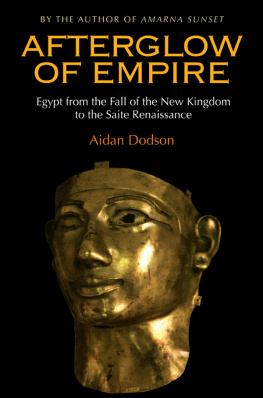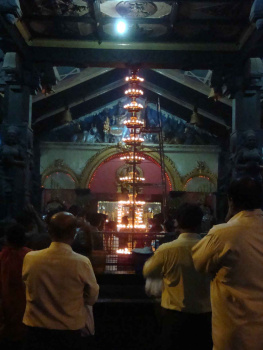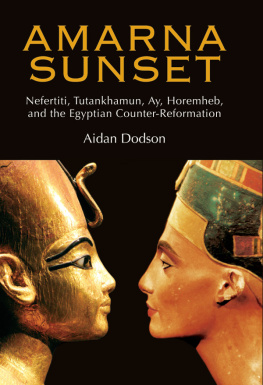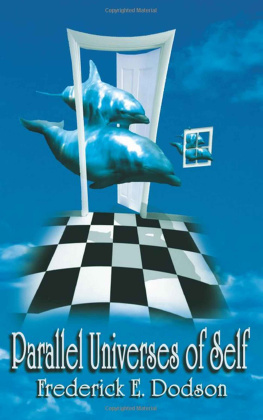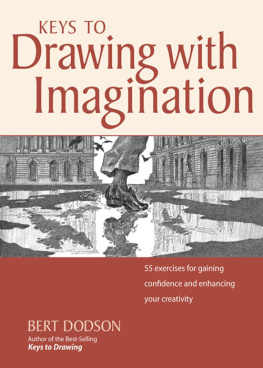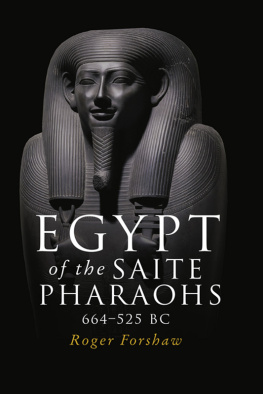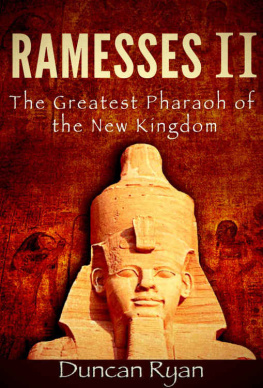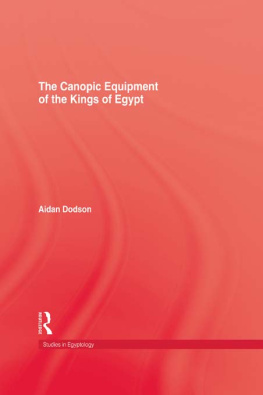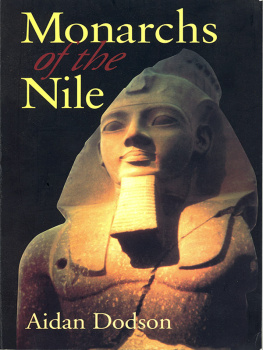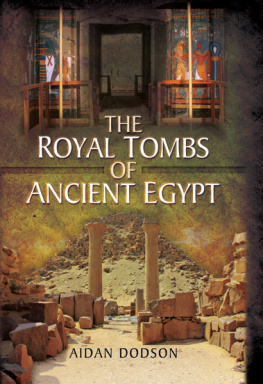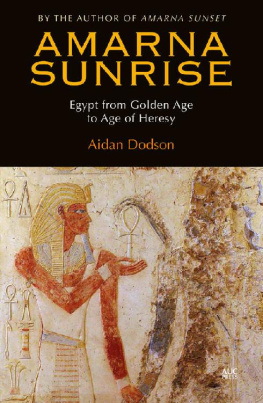AFTERGLOW
OF EMPIRE
AFTERGLOW OF EMPIRE
Egypt from the Fall of the New Kingdom to the Saite Renaissance
Aidan Dodson
The American University in Cairo Press
Cairo New York
First published in 2012 by
The American University in Cairo Press
113 Sharia Kasr el Aini, Cairo, Egypt
420 Fifth Avenue, New York, NY 10018
www.aucpress.com
Copyright 2012 Aidan Dodson
All rights reserved. No part of this publication may be reproduced, stored in a retrieval system, or transmitted in any form or by any means, electronic, mechanical, photocopying, recording, or otherwise, without the prior written permission of the publisher.
Dar el Kutub No. 11216/11
ISBN 978 977 416 531 3
Dar el Kutub Cataloging-in-Publication Data
Dodson, Aidan
Afterglow of Empire: Egypt from the Fall of the New Kingdom to the Saite Renaissance /Aidan Dodson. Cairo: The American University in Cairo Press, 2012 |
p. cm. |
ISBN 978 977 416 531 3 |
1. EgyptAntiquities |
|
1 2 3 4 5 15 14 13 12
Designed by Adam el-Sehemy
Printed in Egypt
To Martin Davies, Esq.: President of the Egypt Society of Bristol, Vice-President of the Egypt Exploration Societyand most importantly, friend!
CONTENTS
T his book, like my previous volumes on the ends of the Eighteenth and Nineteenth Dynasties, represents a distillation of research and thinking that goes back many years. In the present case, my first real acquaintance with the intricacies of the Third Intermediate Period and its immediate precursor and successor eras was gained something over three decades ago, when as a schoolboy I first perused a copy of Kenneth Kitchens seminal book on the topic.
The publication of the first edition of that work in 1973 (with updates in 1986 and 1996) put forward an analysis and historical reconstruction that were so impressive that for some years its conclusions became all but canonical. However, as the 1980s proceeded, scholarly studies that in many cases had originally intended to refine the Kitchen picture began to raise issues that gave rise to significant questions as to the correctness of what had now become orthodoxy. These multiplied in the following years, resulting in a collapse of many significant aspects of the consensus, significant ramifications of which were explored at a conference at Leiden University in the Netherlands in October 2007.
In addition, the same period saw assaults on orthodox views of the period from more radical standpoints, which questioned not only the detail, but also the whole chronological structure of ancient history prior to the seventh century bc. These new paradigms attempt to lower all dates prior to the start of the New Kingdom by a number of centuries, resulting in a very significant compression of the New Kingdom and Third Intermediate Period, requiring overlaps of reigns and dynasties far in excess of anything seriously attempted before.
A side issue is that the challenge of the radicals has driven a number of conventional scholars into the bunker, from where they attempt to defend their current orthodoxy rather more fiercely than had hitherto been the case, perhaps fearful of allowing the radicals some kind of oblique victory. As a result, attempts at challenging the chronological consensuseven in a relatively modest waycan risk being dismissed out of hand as potentially giving comfort to the radicals by showing flaws in the received wisdom, or simply as a result of having used an argument previously deployed by one of them.
For my own part, engagement with these radicalsbroadly my academic contemporariesled me to start retesting the conclusions generally reached on various aspects of the period, resulting in a series of standalone studies, some of which stood the test of time, some of which did not. Among the former was building on a radical observation to verify the existence of a hitherto unnoticed king Shoshenq (IV); which, however, did not attempt to address any issues beyond those I had already dealt with separately.
However, an invitation to write entries on various individual kings for a forthcoming encyclopedia of ancient history led to my beginning to take a closer look at the detail of many parts of the Third Intermediate Period and the late Rameside Period. This led me away from some positions I had long accepted, and prodded me into writing the book-length treatment with which I had been toying for some years. Furthermore, my dear friend Professor Salima Ikram, who had invited the aforesaid contributions, at the same time increased pressure on me in this direction, citing the lack of an up-to-date and accessible treatment that she could set for her students.
Against this background, this books intent is therefore to provide an accessible account of the Third Intermediate Period, and the immediately preceding and succeeding decades, informed by the latest data and addressing the key issues that are presently the subject of active debate, while testing any received wisdom before choosing to accept it. As always with such a work, there is an inherent tension between providing a coherent and readable narrative of events and taking into account a range of variant views that may include questioning whether some events even took place. All I can say is that I have aimed to steer a course that minimizes the number of assumptions and maximizes the reading of hard data in the most straightforward way.
Chronologically, while fully understanding and sympathizing with the issues that have given rise to ultra-radical revisionism, I find it impossible to accept the two key assumptions that make anything more than a few decades adjustment practicable: discarding all conclusions predicated on the pre-Ashur-dan II (late tenth century) segment of the Assyrian King List, and denying the equation between the Biblical Egyptian king Shishak and Shoshenq I, founder of the Twenty-second Dynasty. On the other hand, it seems to me clear that the current strict orthodoxy concerning the absolute dating (i.e., in terms of years bc) of the New Kingdom and Third Intermediate Period is no longer viable, and that some degree of adjustment of datesdownwardis both necessary and desirable.
To do otherwise is to make the macro-level chronological tail wag the micro-level dog, a course that is particularly undesirable when this is used to damn as impossible potential solutions to longstanding anomalies that are otherwise convincing and internally coherent. This becomes even more the case when it is realized that that tail depends entirely on the long-held assumption that Assyrian chronology is absolutely reliable back into the fourteenth centuryand thus that the earlier part of the Assyrian King List is an accurate record of pre-tenth century dynastic history.
As already noted, while I would not take the ultimately nihilistic position that this King List tradition should simply be discarded, it must certainly be tested where possible, and as a result the chronology adopted as the underlying framework of this book incorporates a modest revision of pretenth century dates, in particular a lowering of the long-canonical 1279 BC accession date of Rameses II to 1265. The justification will be found in Chapter 1, where I endorse a proposal that reigns in the late Twentieth Dynasty that have historically been regarded as consecutive were actually in part contemporary; and in Appendix 1, which reviews the broader chronological issues, including the Assyrian King List tradition.
As has already been indicated, my thinking on the period has been stimulated by various formal and informal discussions over the past three decades. Accordingly, I must thank in particular Peter James, Robert Morkot, and David Rohl for their friendly provocations, and a wide range of other friends and colleagues for information and debate in both formal and informal contexts. I am also indebted to Tine Bagh and Salah El-Masekh for help in gaining access to monuments in Copenhagen and at Karnak, respectively, and to Giuseppina Lenzo, Frdric Payraudeau, and Troy Sagrillo (as well as Peter James and Robert Morkot) for advance copies of as yet unpublished work. Reg Clarke, Martin Davies, Claire Gilmour, Salima Ikram, and my wife Dyan Hilton are also to be thanked for their scrutiny of the typescript, and Martin as usual for the free run of his photographic archive. All remaining errors and cases of fuzzy or faulty logic are of course entirely my responsibility!
Next page
